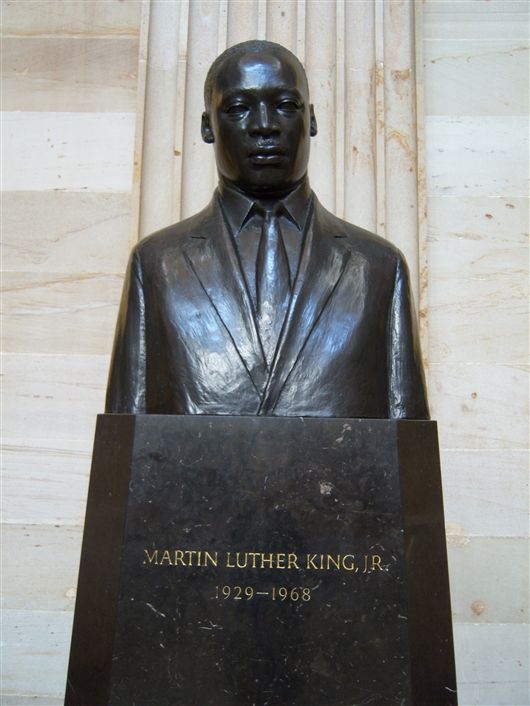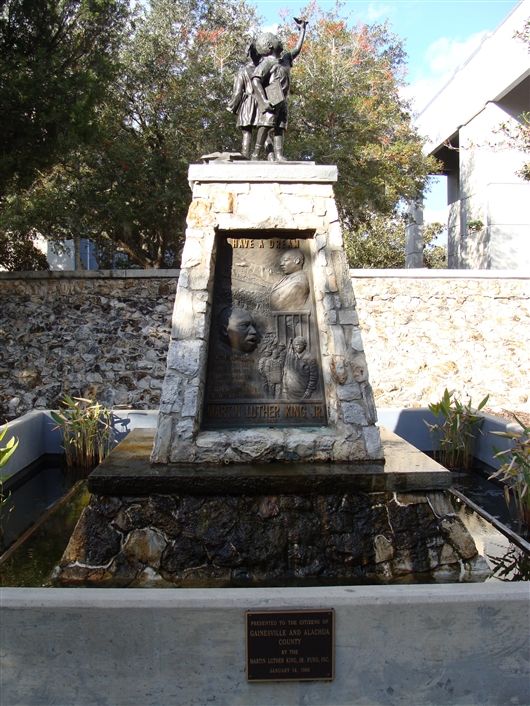博文
Martin Luther King Day
|
Dr. Martin Luther King Day
"We will not resort to violence.
We will not degrade ourselves with hatred.
Love will not be returned with hate."
Dr. Martin Luther King, Jr.
The Third Monday in January of every year in the
It was December, 1955, and Martin Luther King, Jr. had just received his doctorate degree in theology. He had moved to
African-Americans were not only segregated on buses throughout the south. Equal housing was denied to them, and seating in many hotels and restaurants was refused.
In 1957, Dr. King founded the Southern Christian Leadership Conference and moved back to his home town of
On August 28, 1963, a crowd of more than 250,000 people gathered in
One year later, the Civil Rights Act of 1964 was passed. It was not the first law of civil rights for Americans, but it was the most thorough and effective. The act guaranteed equal rights in housing, public facilities, voting and public schools. Everyone would have impartial hearings and jury trials. A civil rights commission would ensure that these laws were enforced. Dr. Martin Luther King, Jr. and thousands of others now knew that they had not struggled in vain. In the same year Dr. King won the Nobel Peace Prize for leading non-violent demonstrations.
In 1968, Dr. Martin Luther King, Jr. was assassinated while he was leading a workers' strike in
The Making of a
Dr. Martin Luther King, Jr.'s death did not slow the Civil Rights Movement. Black and white people continued to fight for freedom and equality. Coretta Scott King is the widow of the civil rights leader. In 1970, she established the
On Monday, January 20, 1986, in cities and towns across the country people celebrated the first official Martin Luther King Day, the only federal holiday commemorating an African-American. A ceremony which took place at an old railroad depot in
All through the 1980's, controversy surrounded the idea of a Martin Luther King Day. Congressmen and citizens had petitioned the President to make January 15, Dr. Martin Luther King, Jr.'s birthday, a federal holiday. Others wanted to make the holiday on the day he died, while some people did not want to have any holiday at all.
January 15 had been observed as a public holiday for many years in 27 states and
Schools, offices and federal agencies are closed for the holiday. On Monday there are quiet memorial services as well as elaborate ceremonies in honor of Dr. King. On the preceding Sunday, ministers of all religions give special sermons reminding everyone of Dr. King's lifelong work for peace. All weekend, popular radio stations play songs and speeches that tell the history of the Civil Rights Movement. Television channels broadcast special programs with filmed highlights of Dr. King's life and times.
This is a statuary of Dr. Martin Luther King in downtown
The picture was taken in December 1, 2007
Following is a statuary of Dr. Martin Luther King in the lobby of Library of Congress in

https://blog.sciencenet.cn/blog-16687-15080.html
上一篇:准备考试要看什么书?
下一篇:I have a dream
全部作者的精选博文
全部作者的其他最新博文
- • [转载]职场友谊的作用
- • 我回来了
- • 组织留人?
- • 心理资本
- • 高绩效人力资源管理系统
- • 破坏型领导
全部精选博文导读
相关博文
- • 「观点」深度分析:诺贝尔物理学奖为啥授予AI学者,其物理学基础是什么?
- • Analyze 12 PhiProblem for completeness and consistency(初学者版)
- • Analysis of Philosophy by DIKWP Semantic Mathematics(初学者版)
- • Mathematize The 12 Philosophical Problems with DIKWP(初学者版)
- • Validate Completeness and Consistency of Philosophy(初学者版)
- • Understanding of 12 Philosophical Problems by DIKWP(初学者版)
